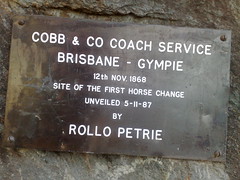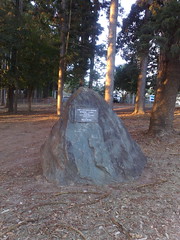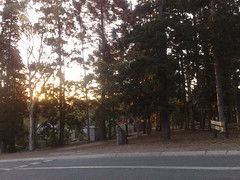Well done, Lilly.
We’re really proud of your performance today at the School Talent Quest.

Well done, Lilly.
We’re really proud of your performance today at the School Talent Quest.



After a tip-off from our local historian, Leith Barter, I found these Pecan Nut trees growiung in Stephen Lawn park, Lawnton.
They were part of a grove planted by “The Acclimatisation Society” in the 1930’s – an organisation created to investigate how best to use the land in this area.
They’re almost 80 years old, and I was curious about them because we live not far from here, on land that was also part of the Acclimatisation Society, and we have a Pecan Nut tree too. But ours is nowhere near as well grown as these majestic specimens.
So the best that I can hope for is that our Pecan is the “son” of a historical nut tree!
Who knows? Maybe it sprouted from a nut dropped by one of the originals.
Thanks, Leith, for patiently answering so many of my questions about our local history!
At the half way point on our 62km cycle around Lake Samsonvale I got an SMS from the kids asking how I was going, so I sent them this pic to let them know I was still alive.
In hindsight, this pic doesn’t say “I’m alive”. More like “I’m the bike monster and I’m going to eat you”. Sorry kids 🙂
Thanks for taking the photo, Steve.
That shirt is a bit bright, isn’t it? And I really need to cut those cable ties off the helmet! The magpies have gone for another year.
The ride itself was hard work. We rode from Petrie, north west to Dayboro, south through Samsonvale to Mount Samson and Yugar, then North East through Draper and Warner home.
The total climb was about 740m or 2,500 feet. That’s the most I’ve ever done in one ride.
I really enjoyed it, but was pretty tired afterwards.
The map below gives you an idea of the route. If you’re interested, here’s a link to Steve’s record of the route which has a nifty little animation that shows you us moving around the map.
Thanks to Stewart Ennis who sent me these amazing photos of Mussoorie in Northern India where my Grandfather, Stewards Dad, Harold (“Pete”) Ennis went to school in the 1920’s.
Stewart visited Mussoorierecently, and tells me he had a great time imagining Pete at school in this mountainous area, where the classrooms have been pretty much unchanged in over 80 years. Stewart thinks if he looked hard enough he might even have found Grandpa’s name carved in a desk somewhere.
Horses and carts are still used for transport, and the red-coated porters, Victorian balustrades, bandstand and promenade are just as they would have been in the 1920’s when Grandpa was there.
If you look closely, you can see “H.Ennis” on the Roll of Honour at the school.
Thanks, Stewart! I would love to go there one day.
We rode from Lawnton to Redcliffe and back today. The round trip was about 50km and took us just over 90 minutes each way. Luckily the trip is mostly flat, so once you settle into a rhythm, it’s pretty effortless. (Honestly, it is!). I’m really impressed with the quality of bikeways along the way, and love the way that the old Hornibrook bridge is available for use by pedestrians and cyclists. It’s a beautiful old bridge, a little run down, but as you can see in this photo, it still has a bit of old charm.
Four of us rode: My mate Simon from next door, Isaac, Harrison and me. The good thing about cycling is that although it’s hard work at times, you get to have some good conversations with the people you’re riding with. Sometimes one or two people might go ahead for a while, but it was a team effort, so we all tried to stick together.
Lunch at the Woody Point pub was a highlight for me. Cold beer tastes magic when you’ve ridden 25km in the heat beforehand. I’d love to do this ride again!
You can see where we went on the map below. Unfortunately the batteries on my phone ran out halfway on the way back, but we started and finished at the same point so it gives you an idea of the route.
Here’s some more pictures of the Mandin Fish Trap on the North Pine River.


View Larger Map
Nineteenth century aboriginal elder Dalaipi lived in what is now Petrie, north of Brisbane.
He was the custodian of several sacred sites in the district including a bora-ring called “Nindur-Ngineddo” (meaning “leech sitting down”).
Sadly, the bora ring today is under the round-about at Petrie, and no trace of it remains.
It does seem ironic that a modern circular traffic construction should be sitting on top of an ancient circular spiritual construction.
Perhaps the spirit of Dalaipi had something to do with that.
You’re supposed to treat a bora ring with respect and not just go blundering through it. The busy traffic makes it virtually impossible for anyone to casually blunder through the site at all. In fact I risked life and limb to just cross the road to get to it.
Although thousands of cars per day drive around it, I think it would be rare for someone to actually walk through it.



Cobb & Co operated a horse -drawn coach service between Brisbane and Gympie in the nineteenth century.
The coaches would stop at “Murrumba” – Tom Petrie’s homestead (now at the top of Armstrong Street, Petrie).
At Murrumba, they’d change the horses, freshen up, and continue the journey to Gympie along what today is known as “Old Gympie Road”.
Nothing remains of the homestead, but Tom’s grandson, Rollo, unveiled this memorial to the coach stop in 1987.
This is a beautiful spot. If you’re ever in Petrie and have a spare ten minutes, walk to the top of Armstrong Street in the grounds of the Catholic Church and Schools. If you’re still, you’ll hear the hoof-beats of the Cobb & Co coach coming up the road.
It’s magic.